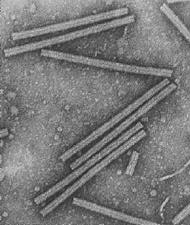|
Viruses Viruses depend on the host cells that they infect, and they need to reproduce. When found outside of host cells, viruses exist as a protein coat, or capsid. Sometimes they are enclosed within a membrane. The capsid encloses either DNA or RNA which codes the virus elements. While in this form outside the cell, the virus is metabolically inert, which means they cannot reproduce or replicate themselves. Examples of metabolically inert viruses are shown below:
The viruses shown on the left is an electron micrograph of a cluster of influenza viruses. Each virus is about about 100 nanometers (billionths of a meter) long. You can see the membrane and and the protein coat. The micrograph on the right shows the virus that causes tobacco mosaic disease in tobacco plants. When a virus comes in contact with a host cell, it inserts its genetic material into its host and takes over all the host's functions. The result is that an infected cell will produce more protein and genetic material instead of its usual products. Some viruses may remain dormant inside host cells for long periods and won't create a change in the host cell. When this happens, it is in a lysogenic phase. When a dormant virus is stimulated, it enters the lytic phase when new viruses form and assemble. Then the viruses leave the cell and kill it as they leave. They then go on to infect other cells. Viruses cause a number of diseases in eukaryotes, which are organisms with membrane bound nuclei. Examples of viral diseases in humans are smallpox, the common cold, chickenpox, influenza, shingles, herpes, polio, rabies, Ebola, hanta fever, and AIDS. Research is showing that even some types of cancer have been linked to viruses. Viruses have not been found in any fossils, but scientists believe that it is possible they were responsible for some of the plant and animal extinctions. One theory suggests that dinosaurs became extinct because of a widespread virus. There is not way to actually prove that this did happen, so it remains only a hypothesis. One strong argument against viruses being responsible for the extinction is that ammonites and foraminifera also became extinct about the same time and there is no way possible that a virus would have been responsible for the extinction of all three life forms. Since viruses transfer genetic material between different species of hosts, they are used in genetic engineering. Viruses carry out natural "genetic engineering" by incorporating some genetic material from the host. It then reproduces and transfers that genetic information to a new host which can even be unrelated to the previous host. This is known as transduction, or the transfer of genetic material from one bacterial cell to another by incorporating DNA into a bacteriophage.
|
||||||||||||||||

